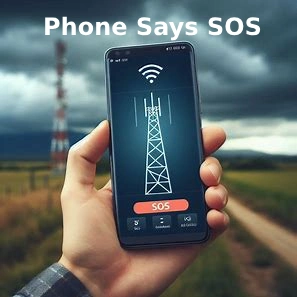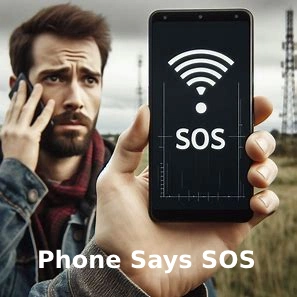Have you ever looked at your phone and noticed that it suddenly says “SOS”? It can be alarming, especially if you’re trying to make a call or send a text. But what exactly does it mean when your phone shows SOS? In this guide, we will explain why your phone says SOS, what it means, and how you can troubleshoot the problem. Understanding the SOS mode on your phone is crucial for maintaining smooth communication, so let’s dive in!
What Does SOS on a Phone Mean?
SOS on a phone is not just a message—it’s a feature that’s meant for emergencies. The SOS feature allows you to make emergency calls when there’s no regular network coverage. When your phone says SOS, it means that your phone can’t connect to its usual network, but it can still connect to certain emergency services, allowing you to make emergency calls.
This feature is particularly helpful if you’re in an area with no signal or if the network is down temporarily.
Why Does My Phone Show SOS?
Your phone might display SOS mode for a variety of reasons. Let’s explore some of the most common causes:

Common Reasons Why Your Phone Says SOS
1. Poor Signal or Network Connection
If you’re in an area with weak or no signal, your phone may switch to SOS mode. This is especially common in rural areas or locations with limited network coverage, like mountains or basements. When your phone detects that it cannot connect to its regular network, it switches to SOS mode.
2. SIM Card Problems
Sometimes, the issue is with the SIM card. If your SIM card is not inserted correctly, is damaged, or if there’s a problem with your account, your phone may show SOS. A faulty or disconnected SIM card can prevent your phone from connecting to the network properly, forcing it into SOS mode.
3. Network Outages or Issues
Occasionally, network outages happen in certain areas. These outages can cause your phone to temporarily lose signal and show SOS mode. This is usually a short-term issue that will resolve once the network is restored.
4. Airplane Mode and Location Settings
If your phone is set to airplane mode, it won’t be able to connect to the network, and it may show SOS. Similarly, location settings or issues with the phone’s ability to connect to cell towers could cause SOS mode to activate.
Learn more about network issues and how to fix them
What to Do When Your Phone Shows SOS
If your phone says SOS, don’t panic. There are several steps you can take to troubleshoot and fix the issue. Here are some common solutions:
1. Check Your Signal and Network Connection
First, check if you have a strong signal. If you’re in a location with poor coverage, try moving to a different area. You might want to try going outside if you’re indoors, especially if you’re in a place with thick walls or underground.
2. Restart Your Phone
Restarting your phone can resolve many common issues. Turn off your phone, wait for about 30 seconds, and then turn it back on. This can help reset the connection to the network and remove any temporary glitches.
3. Remove and Reinsert Your SIM Card
If your SIM card is loose or malfunctioning, it can cause your phone to go into SOS mode. Carefully remove the SIM card, inspect it for damage, and then reinsert it properly. Make sure that it’s placed correctly in the SIM card slot.
4. Turn Off Airplane Mode
Airplane mode disables your phone’s connection to networks, which is why your phone might show SOS. If airplane mode is turned on, turn it off by going to the settings and toggling off airplane mode.
Troubleshooting SOS Mode
Here’s a step-by-step guide for troubleshooting SOS mode on both iPhones and Android phones.
For iPhones:
- Check your signal: Swipe down to view the signal bars. If you see no bars, try moving to a different location.
- Restart the phone: Hold down the power button and slide to turn off your phone. After waiting 30 seconds, press the power button again to turn it on.
- Remove and reinsert the SIM card: Open the SIM card tray and carefully remove the card. Reinsert it properly and restart your phone.
For Android Phones:
- Check for signal issues: Open the notification shade to check the signal strength. If it’s weak, move to a place with better coverage.
- Restart the phone: Hold the power button and restart the phone to reset network settings.
- Check SIM card placement: Open the SIM card tray and check if the SIM is properly placed.
Additional Step: Check for Software Updates
Occasionally, the issue may be related to software bugs or outdated firmware. Check for software updates by going to your phone’s settings and selecting “Software Update.” Updating your phone can sometimes resolve connectivity issues.
Factory Reset (As a Last Resort)
If all else fails, you might consider doing a factory reset. This will erase all data on your phone, so be sure to back up your important files before proceeding. A factory reset can help fix software-related issues that may be causing SOS mode.
It you want to read more about technology, visit our website’s Tech Section.
How to Prevent SOS Mode from Reoccurring
To avoid the SOS mode from appearing again, here are a few preventive measures you can take:
- Ensure Strong Network Coverage: When possible, stay in areas with strong network coverage.
- Maintain SIM Card Health: Make sure your SIM card is properly inserted and in good condition.
- Check for Network Settings: Regularly check your phone’s network settings to ensure they’re configured correctly.

FAQs About SOS Mode on Phones
Q1: Why does my phone say SOS but I have signal?
Sometimes, your phone may detect a weak or unstable signal, even if you see signal bars. This can cause it to switch to SOS mode. Make sure you’re in an area with a stable connection.
Q2: Can SOS mode affect emergency calls?
No, SOS mode is designed to allow emergency calls even if there’s no regular network coverage. Your phone should still be able to connect to emergency services.
Q3: Is there a way to turn off SOS mode permanently?
You cannot turn off the SOS feature entirely because it’s built into your phone for safety reasons. However, troubleshooting network issues or fixing SIM card problems can prevent SOS mode from appearing.
Final Words
If your phone says SOS, it can be concerning, but it’s typically an issue that can be fixed with a few simple steps. Whether it’s a problem with the signal, SIM card, or network, most of the time the issue can be resolved by checking your settings, restarting your phone, or ensuring that your SIM card is properly inserted. By following the troubleshooting steps and ensuring strong network coverage, you can avoid SOS mode in the future.
If the problem persists, consider reaching out to your carrier or customer service for further assistance. Remember, SOS mode is a feature that’s there for your safety, so it’s important to address any issues with it quickly.




